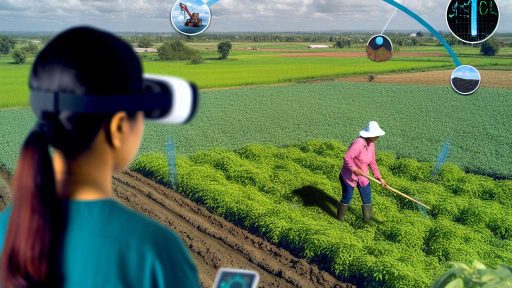Overview of Renewable Energy
Definition and Importance in Agriculture
Renewable energy refers to energy sourced from natural processes that are continuously replenished.
This includes solar, wind, geothermal, and biomass energy.
In agriculture, renewable energy plays a crucial role in sustainability.
Farmers increasingly adopt these energy solutions to reduce costs.
Furthermore, renewable energy minimizes environmental impact.
By utilizing clean energy, farms contribute to reducing greenhouse gas emissions.
Ultimately, renewable energy enhances farm resilience and productivity.
Types of Renewable Energy Solutions in Agriculture
Solar energy acts as a primary resource for many farming operations.
Farmers install solar panels to generate electricity for operations.
Wind turbines also harness wind energy on agricultural land.
This technology produces power while utilizing large areas effectively.
Geothermal energy provides an alternative for heating purposes.
Farmers can use this for greenhouse heating, enhancing crop growth.
Additionally, biomass energy offers a method of repurposing waste materials.
This approach turns leftover crop and animal waste into usable energy.
Transform Your Agribusiness
Unlock your farm's potential with expert advice tailored to your needs. Get actionable steps that drive real results.
Get StartedBenefits of Renewable Energy in Agriculture
Cost savings represent one of the primary benefits of renewable energy use.
By reducing reliance on fossil fuels, farmers lower their energy bills.
Moreover, renewable energy boosts local economies through job creation.
It generates employment in installation, maintenance, and operation sectors.
Furthermore, renewable energy increases farm independence from energy suppliers.
This strategy empowers farmers to control their energy production.
Finally, adopting renewable energy enhances agricultural sustainability.
It aligns with global goals for sustainable development and environmental health.
Solar Energy Integration: Benefits and Applications in Modern Farms
Harnessing Solar Power
Farmers increasingly turn to solar energy to enhance operations.
Solar panels capture sunlight, converting it into electricity.
This process significantly reduces energy costs for farms.
Moreover, solar energy is sustainable and environmentally friendly.
Farmers can utilize this energy for various applications.
Cost Savings and Efficiency
Integrating solar energy leads to substantial cost savings.
It reduces reliance on traditional fossil fuels.
Consequently, this shift improves overall energy efficiency.
Solar energy provides a reliable power source during peak usage times.
Farmers successfully manage irrigation systems using solar-powered pumps.
Environmental Impact
Solar energy integration contributes to environmental sustainability.
It lowers greenhouse gas emissions significantly.
Additionally, solar panels utilize land efficiently without disrupting ecosystems.
Farmers practice eco-friendly methods while boosting productivity.
This approach aligns agriculture with renewable energy goals.
Enhancing Crop Production
Solar energy supports technologies that enhance crop yields.
Showcase Your Farming Business
Publish your professional farming services profile on our blog for a one-time fee of $200 and reach a dedicated audience of farmers and agribusiness owners.
Publish Your ProfileFarmers can implement automated systems powered by solar energy.
These systems monitor soil moisture and nutrients effectively.
As a result, crop health and productivity improve.
Integrating solar technology promotes precision agriculture practices.
Financial Incentives and Support
Government initiatives often provide financial support for solar integration.
Subsidies and tax credits significantly ease initial installation costs.
Farmers can take advantage of grants to adopt solar technology.
This financial assistance encourages a broader adoption of renewable energy.
Consequently, more farms transition towards sustainable operations.
Case Studies of Successful Implementation
Numerous farms have successfully integrated solar energy.
Sunny Acres Farm in California reduced energy bills by 40%.
They installed solar panels covering their barn roof.
Similarly, Green Fields Farm in Texas utilizes solar-powered irrigation.
This transition improved their operational efficiency and reduced costs.
Wind Energy Solutions for Large-Scale Agricultural Operations
Introduction to Wind Energy in Agriculture
Wind energy offers significant benefits for large-scale agricultural operations.
This renewable source provides a sustainable energy alternative.
Farmers can reduce their dependence on fossil fuels through wind power.
Additionally, this energy source helps to cut operational costs.
Benefits of Wind Energy for Farmers
Implementing wind energy enhances energy independence.
Farmers can generate their own electricity on-site.
This leads to reduced electricity costs over time.
Moreover, wind energy systems require minimal maintenance.
- Their lifespan averages over 20 years.
- They can operate efficiently in various weather conditions.
- Farmers benefit from government incentives and tax credits.
Types of Wind Energy Solutions
There are various types of wind energy solutions available.
Horizontal-axis wind turbines are the most common option.
These turbines consist of two or three blades mounted on a tower.
Vertical-axis wind turbines are also gaining popularity.
They have a unique design that captures wind from any direction.
Integrating Wind Energy into Agricultural Procedures
Farmers can incorporate wind energy into their operations seamlessly.
Wind turbines can power irrigation systems efficiently.
Furthermore, they can supply energy for livestock operations.
This integration minimizes the reliance on external energy sources.
Challenges and Considerations
Implementing wind energy solutions presents challenges.
Site selection is critical for maximizing wind energy production.
Farmers need to assess the local wind patterns carefully.
Additionally, initial installation costs can be significant.
However, the long-term savings often outweigh these upfront investments.
Future Potential of Wind Energy in Agriculture
The future of wind energy in agriculture looks promising.
Technological advancements continue to improve turbine efficiency.
Additionally, more farmers are recognizing the benefits.
This trend indicates a potential increase in wind energy adoption.
Showcase Your Farming Business
Publish your professional farming services profile on our blog for a one-time fee of $200 and reach a dedicated audience of farmers and agribusiness owners.
Publish Your ProfileAs sustainability becomes a priority, wind energy will play a vital role.
See Related Content: Exploring Controlled Environment Agriculture Technologies for Farmers
Biogas Production from Agricultural Waste
Understanding Biogas
Biogas is a renewable energy source produced from organic materials.
It mainly consists of methane and carbon dioxide.
This gas forms through anaerobic digestion, a natural decomposition process.
Farmers can harness biogas for heating, electricity, or vehicle fuel.
Benefits of Biogas Production
Biogas production offers multiple advantages for agricultural operations.
It reduces waste by converting agricultural residues into energy.
This process minimizes the environmental impact of waste disposal.
Additionally, it creates a sustainable energy solution for farmers.
Types of Agricultural Waste Used
A variety of agricultural waste can generate biogas.
Common sources include manure, crop residues, and food-processing waste.
These materials are abundant and often underutilized.
Utilizing them for biogas helps close the loop in farming operations.
Implementing Biogas Systems
Setting up a biogas system requires careful planning.
Farmers should assess the availability of organic material first.
Next, they need to choose an appropriate biogas digester design.
Moreover, understanding local regulations and incentives is essential.
Case Studies of Successful Biogas Projects
Several farmers have successfully implemented biogas systems.
For instance, Green Valley Farm converted their livestock manure into energy.
This initiative helped them meet energy needs and cut costs.
Similarly, Riverbend Organic Farm uses crop residues to produce biogas.
Future of Biogas in Agriculture
The future of biogas production in agriculture is promising.
As technology improves, efficiency will further increase.
Incentives for renewable energy may continue to grow.
Thus, biogas can play a vital role in sustainable farming.
Find Out More: AI-Based Soil Health Analysis Tools
Hydropower Utilization: Innovative Strategies for Irrigation and Crop Management
The Role of Hydropower in Agriculture
Hydropower can significantly enhance agricultural productivity.
It provides a reliable source of energy for various farming operations.
Farmers increasingly adopt hydropower for effective irrigation management.
This strategy minimizes dependency on fossil fuels.
As a result, it reduces carbon emissions and promotes sustainability.
Innovative Irrigation Systems
Modern hydropower systems support advanced irrigation techniques.
For instance, drip irrigation allows precise water delivery to crops.
This method conserves water while maximizing crop yield.
Additionally, surge irrigation techniques optimize water distribution across fields.
Farmers can now manage water resources efficiently through automation.
Benefits to Crop Management
Utilizing hydropower leads to improved soil management practices.
It enhances soil moisture retention critical for crop growth.
Moreover, reliable irrigation boosts crop resilience against drought conditions.
Showcase Your Farming Business
Publish your professional farming services profile on our blog for a one-time fee of $200 and reach a dedicated audience of farmers and agribusiness owners.
Publish Your ProfileThis approach fosters economic stability for farming communities.
Furthermore, it enables the cultivation of diverse crops year-round.
Case Studies of Successful Implementation
Several farms have successfully integrated hydropower into their operations.
The Green Valley Farm in Idaho showcases effective hydropower usage.
They implemented a hydropowered irrigation system that increased yields by 30%.
Similarly, the Riverbend Orchard in Oregon utilizes hydropower for frost control.
These innovations not only enhance productivity but also reduce operational costs.
Challenges and Solutions
Despite its benefits, there are challenges in hydropower adoption.
Initial installation costs can be high, deterring some farmers.
To address this, governments can offer subsidies and grants.
Additionally, training programs can equip farmers with necessary skills.
Collaboration between technology providers and farmers is essential for success.
Delve into the Subject: Smart Farming Solutions Through Controlled Environment Agriculture
Geothermal Energy: Harnessing Earth’s Heat for Greenhouses and Livestock Facilities
Introduction to Geothermal Energy
Geothermal energy is a powerful renewable resource.
It utilizes heat from the Earth’s core to generate energy.
This energy can significantly reduce reliance on fossil fuels.
Farmers can use geothermal energy for various agricultural purposes.
Benefits of Geothermal Energy in Agriculture
Utilizing geothermal energy can enhance crop yields.
This method ensures consistent temperatures for greenhouse growth.
Furthermore, livestock facilities benefit from stable heating.
Animals thrive in controlled thermal environments.
Reducing energy costs is another highlight of geothermal use.
Applications in Greenhouses
Geothermal energy provides heating solutions for greenhouses.
It creates a favorable climate for plant growth year-round.
Additionally, this energy source can warm soil, enhancing plant health.
Farmers like Emily Foster have successfully implemented these systems.
She reports a 30% increase in tomato production using geothermal heat.
Impact on Livestock Facilities
Farms benefit from heating water systems for livestock.
Geothermal energy can provide warm water for cleaning and feeding.
Additionally, maintaining optimal barn temperatures improves animal welfare.
Cattle, for instance, produce more milk in thermally regulated conditions.
These improvements lead to enhanced overall productivity.
Challenges and Considerations
Despite the benefits, geothermal energy presents some challenges.
Initial installation costs can be substantial.
However, long-term savings often outweigh these upfront expenses.
Farmers must also assess site suitability for geothermal systems.
Conducting thorough geological surveys is essential before installation.
Future Prospects of Geothermal Energy in Agriculture
The future looks promising for geothermal energy in farming.
Continued technological advancements will reduce costs.
Moreover, increased awareness of environmental impacts fuels interest.
Showcase Your Farming Business
Publish your professional farming services profile on our blog for a one-time fee of $200 and reach a dedicated audience of farmers and agribusiness owners.
Publish Your ProfileAs more farmers adopt this technology, efficiency will improve.
The transition to geothermal energy aligns perfectly with sustainable agriculture goals.
Uncover the Details: Blockchain Technology Improving Supply Chain Transparency For Farmers

Energy Efficiency Practices
Introduction to Energy Efficiency
Energy efficiency is crucial for modern agricultural operations.
It helps reduce operational costs while promoting sustainability.
Adopting renewable technologies enhances overall productivity.
Benefits of Renewable Technologies
Renewable technologies lower energy costs immediately.
They also minimize dependence on fossil fuels.
This transition supports environmental conservation efforts.
Common Renewable Technologies
Solar energy systems are popular in agriculture today.
They provide a reliable source of power.
Wind turbines also serve as effective energy solutions.
These technologies significantly reduce energy bills.
Implementing Energy Efficiency Practices
Assess energy needs to identify inefficiencies first.
Next, integrate renewable energy systems into operations.
Additionally, consider energy-efficient machinery and equipment.
Case Studies
Smith Family Farms reduced costs by installing solar panels.
The switch saved them 30% on energy expenses annually.
Green Meadow Farm utilizes wind power effectively.
They now achieve 50% of their energy from renewable sources.
Incentives for Adoption
Government programs often offer financial incentives.
Tax credits and grants make the transition more affordable.
Farmers can significantly benefit from these opportunities.
Looking Ahead
The future of agriculture relies on energy efficiency.
Embracing this change will lead to sustainable practices.
Ultimately, this improves the economic viability of farms.
Case Studies: Successful Implementation of Renewable Energy in Farming
Transitioning to Solar Energy
Green Acres Farm recently transitioned to solar energy.
This change significantly reduced its energy costs.
They installed solar panels across their barn roofs.
As a result, they now generate more energy than they use.
Additionally, they sell excess energy back to the grid.
This revenue stream helps fund other sustainable initiatives.
Adopting Wind Power
Sunny Valley Orchards embraced wind power to enhance sustainability.
The installation of wind turbines met their energy needs effectively.
This move not only reduced their carbon footprint but also cut costs.
Moreover, they generated power during peak demand hours.
The farm now promotes its eco-friendly practices in marketing campaigns.
Implementing Biomass Solutions
Blue Ridge Livestock Farms implemented biomass systems for energy.
They converted waste into bioenergy, addressing waste disposal issues.
This method also provides heating for their facilities.
Showcase Your Farming Business
Publish your professional farming services profile on our blog for a one-time fee of $200 and reach a dedicated audience of farmers and agribusiness owners.
Publish Your ProfileConsequently, they improved their overall energy efficiency.
The farm’s sustainability efforts attracted positive media attention.
Utilizing Geothermal Energy
Mountainview Greenhouses adopted geothermal heating technology.
This technology effectively warms their greenhouses year-round.
The investment led to increased crop yields during colder months.
Farmers noted significant decreases in heating costs.
Additionally, it contributes to a greener farming operation.
Integrating Renewable Energy into Daily Operations
Many farms now integrate renewable energy sources into daily operations.
These systems improve overall efficiency and productivity.
For instance, LED lighting powered by solar energy enhances visibility.
Furthermore, electric machinery reduces fossil fuel dependency.
Overall, renewable energy solutions lead to long-term financial savings.
Future Trends: Technological Innovations in Renewable Energy for Agriculture
Emerging Technologies
Emerging technologies are shaping the future of agriculture.
Solar energy adoption is rapidly increasing among farmers.
Farmers now harness solar panels to power irrigation systems.
Moreover, wind energy is becoming a viable option for agricultural operations.
Wind turbines provide an efficient method to generate power on-site.
Biogas production from agricultural waste is also gaining traction.
This technology transforms waste into valuable energy resources.
Integration of Smart Solutions
Smart technology integrates renewable energy solutions seamlessly into farming.
IoT devices monitor energy usage in real-time.
This integration helps farmers optimize energy consumption.
Additionally, precision farming techniques enhance resource management.
Automated systems reduce waste and improve efficiency.
Collaboration and Investment
Collaboration between technology firms and farmers fuels innovation.
Investments in renewable energy are on the rise.
Many agricultural businesses are seeking sustainable energy partners.
This collaboration drives development across the agricultural sector.
Furthermore, government incentives encourage adoption of these technologies.
Adapting to Climate Change
Renewable energy solutions address the challenges posed by climate change.
Farmers increasingly seek ways to minimize their carbon footprint.
Innovative energy solutions contribute to more resilient agricultural practices.
This shift promotes sustainable farming and environmental stewardship.
Consequently, farmers enhance their operational efficiency and profitability.
Additional Resources
Innovative Agriculture Technologies Transforming the Industry | ICL
National Renewable Energy Laboratory (NREL) Home Page | NREL




